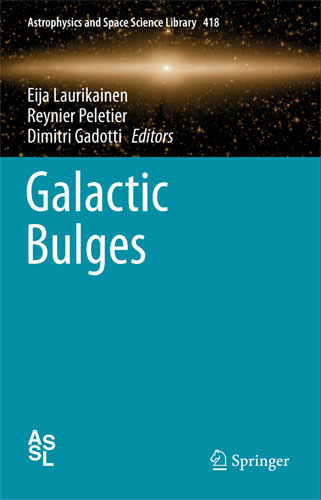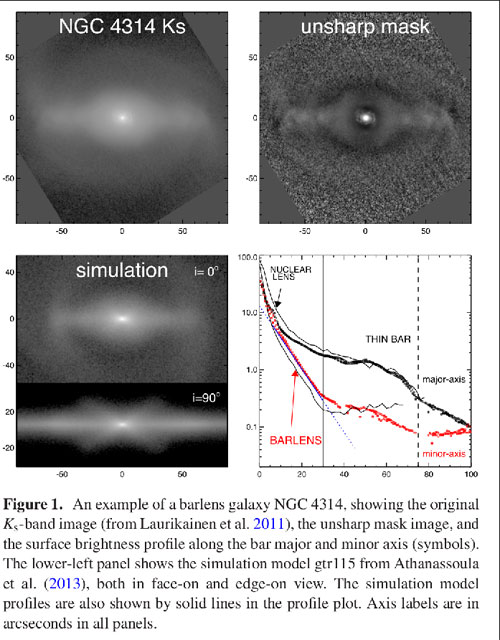Extragalactic research
We use data from ground-based and space telescopes, including modern instruments at European Southern Observatory (ESO). We do dynamical modeling of galaxies using both N-body codes developed in our group (Salo & Laurikainen 2000a,b), and with other codes in collaboration with other researchers. We have developed both 2D-decomposition structural decomposition methdods (see BDBAR, Laurikainen et al. 2005), and methods for estimating the gravitational field of the galaxies from near-IR images (NIRQB, Laurikainen and Salo 2002).
1. Structural decompositions
The Astronomy Research unit in Oulu has been one of the pioneers in developing methods of detailed multi-component photometric decompositions, and applying them to large galaxy samples. Detailed decompositions (Laurikainen et al. 2010) were obtained for the Near-IR S0 Galaxy Survey (NIRS0S , Laurikainen et al. 2011) of ~200 galaxies. The two-dimensional flux distributions of galaxies were fitted with functions describing bulges, disks, bars, and lenses, using BDBAR-code. We found that even in the "bulge dominated" lenticular galaxies (S0s), in fact only 10-30 % of the light belongs to relaxed central spheroids, i.e., classical bulges. In the same study we found that some SOs have extremely low mass bulges, which led us to suggest that S0s form a sequence parallel with that of Sa - Sc spirals in the Hubble sequence, with systematically decreasing bulge-to-total flux ratio. A similar conclusion has been made by Kormendy & Bender (2012), and also by Cappellari et al. (2011), using kinematic observations.
We have applied a similar decomposition approach to the Spitzer Survey of Stellar Structure in Galaxies (S4G, Sheth et al. 2010) at 3.6 micron wavelength, for ~2300 nearby galaxies. These S4G "pipeline 4" decompositions (Salo et al. 2015) were carried out with the GALFIT-code (Peng et al. 2002, 2010). The S4G decompositions form one of the largest databases of detailed photometric multi-component decompositions of galaxies, covering a large range of galaxy masses ( 108 - 1011 solar masses). We are currently applying a similar decomposition method to other galaxy surveys.
2 Book on 'Galactic Bulges'
 When theoretical models are compared with observations the observers do not always mean the same thing when they talk about galactic bulges.
Also, due to the colorful background of the concept of the bulge, it can refer to extra flux in the disk plane, to a spheroidal central component
in a galaxy, or to the vertically extended central part of the bar. Some of these structures can be recurrent, while others are long lasting.
In order to bring the observers and people working with theoretical models closer to each other, we initiated a book on
'Galactic Bulges' (eds. Laurikainen, Peletier, Gadotti)
published by Springer in 2016.
When theoretical models are compared with observations the observers do not always mean the same thing when they talk about galactic bulges.
Also, due to the colorful background of the concept of the bulge, it can refer to extra flux in the disk plane, to a spheroidal central component
in a galaxy, or to the vertically extended central part of the bar. Some of these structures can be recurrent, while others are long lasting.
In order to bring the observers and people working with theoretical models closer to each other, we initiated a book on
'Galactic Bulges' (eds. Laurikainen, Peletier, Gadotti)
published by Springer in 2016.
The book collects 16 reviews of different aspects of extra-galactic bulges,
as well as of the Milky Way bulge, written by specialists in the field. The book contains also a historical and philosophical background of
the concept of the bulge. Also, a connection of bulges with Super-massive Black Holes, and with Modified Newtonian Dynamics (MOND) are discussed,
and possible yet unresolved problems in the field are summarized.
3. Barlenses, face-on counterparts of Boxy/Peanut bulges
It was emphasized in the book on "Galactic Bulges" that most of the flux generally associated to spheroids (i.e., classical bulges) can actually form part of the bar. In the edge-on view such "bulges" are known to appear as Boxy/Peanut or X-shaped structures, formed in processes where stars are buckled to higher galactic latitudes. We have further shown, based on observations (Laurikainen et al. 2014) and on simulation models (Athanassoula et al. 2015), that also the roundish structures in the central parts of bars in nearly face-on view are manifestations of the same bar components (see Fig. 1). This is important because these roundish components are generally interpreted as spheroids, which in the simulation models typically form in galaxy mergers. The models by Athanassoula et al. (2015) used hydrodynamical simulations, in which models barlenses were formed in conjunction with the bar formation.

Our recent simulation models (Salo & Laurikainen 2016; see also Laurikainen & Salo 2016) have further demonstrated, that in order to see a barlens in face-on view, the galaxies need to have massive compact central regions, in a scale much smaller than the vertically thick bar component. What are the classical bulges in galaxies remains a puzzle that we plan to tackle by comparing bar/bulge photometry with kinematic and stellar population analysis, in collaboration with the specialists in these analysis methods. This study we are carrying out in different galaxy environments.
4. Integral-Field observations with MUSE
Integral-field-unit (IFU) spectroscopic observations are a powerful tool to study the two dimensional distribution of stellar populations and kinematics of galaxies. A new IFU instrument, MUSE, has been recently attached to the 8m VLT telescope at the European Southern Observatory (ESO). It already has the sensitivity and large enough field of view to study the structure components of nearby galaxies. We are particularly interested in thick disks (e.g., are thicker than the thin disks of almost same size) in galaxies, structures which contain stars that are almost as old as the Universe itself. Those stars are also nearly as old as the stars in galactic bulges, including the vertically thick inner bar components. An open question is, is this just a coincidence, or are the formative processes of bulges and thick disks coupled.
MUSE kinematics for one galaxy with a thick disk, ESO 243-49, is shown on the page Galactic Rings and Thick Discs (from Comerón et al. 2016)
5. Dwarf galaxies in clusters
New instruments have been developed at ESO (MegaCam, OmegaCAM at ESO) for making extremely deep images of galaxies, with a large field-of-view. The OmegaCAM instrument has been developed by the University of Groningen. Recent observations with these instruments have shown that fairly isolated galaxies, previously classified as featureless, can have huge, extended low surface brightness structures (Duc et al. 2015; Iodice et al. 2016). Also, new type of low mass, and low surface brightness galaxies have been discovered in galaxy clusters, including the Virgo, Coma, and Fornax clusters. We are involved in the imaging studies of the low surface brightness galaxies in the Fornax cluster led by University of Groningen, via a double-degree PhD project, and via a new SUNDIAL Marie Sklodowska-Curie Innovative training network, starting 2017. The dwarf galaxies provide an excellent test laboratory to study the environmental effects. This is because they, besides being the most numerous galaxies in the Universe, are also expected to be very vulnerable to environmental processing because of thei low masses. One Fornax field in r'-band is shown in Fig. 3 (Venhola et al. in preparation).

Fig.3: A r'-band cut from the field 16 of the Fornax cluster. The red ellipses point out the objects which were classified as Ultra Diffuse Galaxies. The image is shown in the logarithmic scale. (From Venhola et al. in preparation).
6. Interacting galaxies
We have also experience of detailed dynamical modeling of interacting galaxy pairs, of which an example is the model for M51 (Salo & Laurikainen 2000a,b), compared with S4G Spitzer image.


